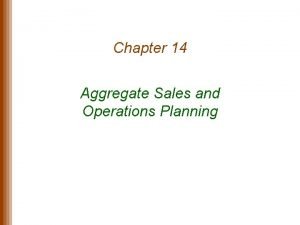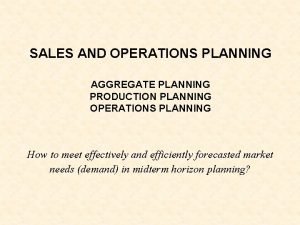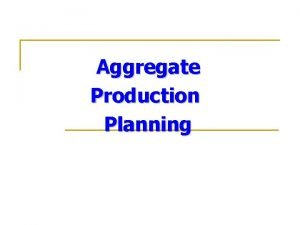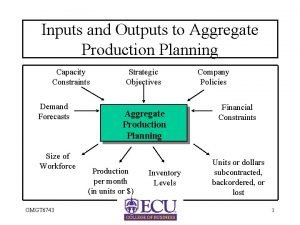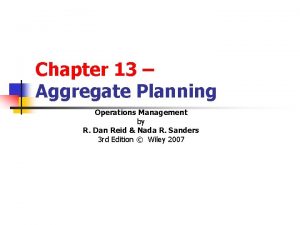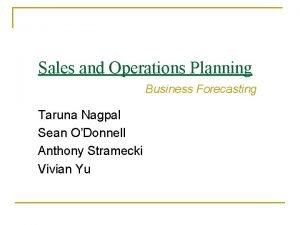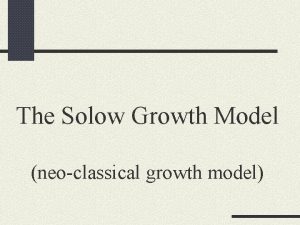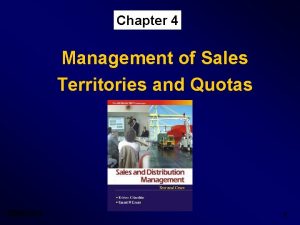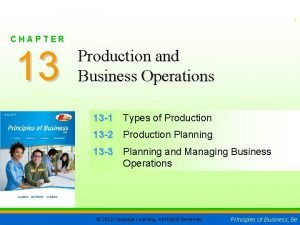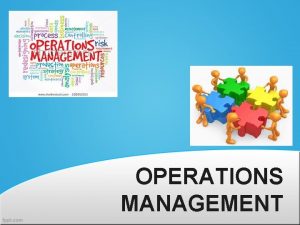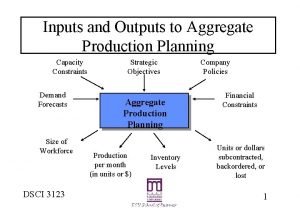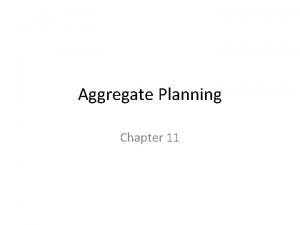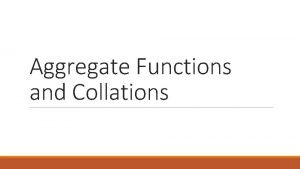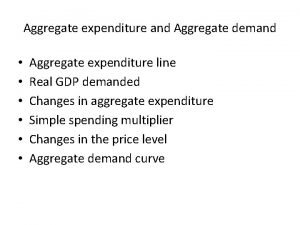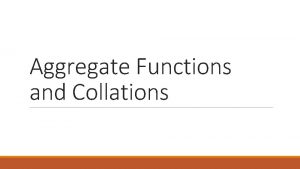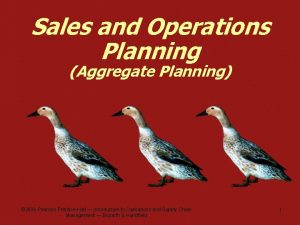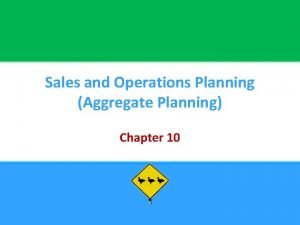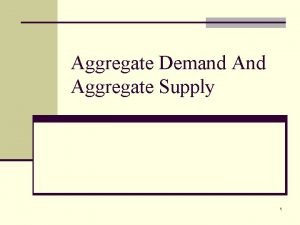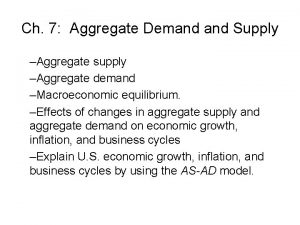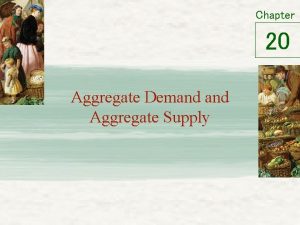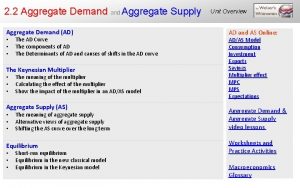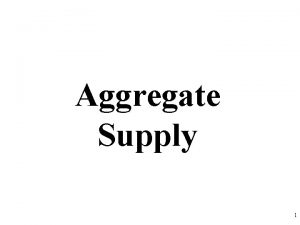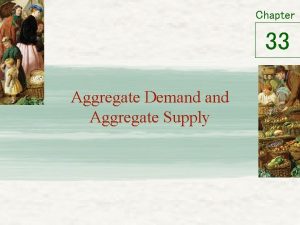SALES AND OPERATIONS PLANNING AGGREGATE PLANNING PRODUCTION PLANNING

















![Example Planning period (month) 01 02 03 04 05 06 Total Demand forcast [unit] Example Planning period (month) 01 02 03 04 05 06 Total Demand forcast [unit]](https://slidetodoc.com/presentation_image_h/838f2f4f6fd7bb82c333791cc0d9f5c0/image-18.jpg)
![Plan A – LEVEL CAPACITY STRATEGY (pure) Planning period DEMAND [units] PRODUCTION PLAN [units] Plan A – LEVEL CAPACITY STRATEGY (pure) Planning period DEMAND [units] PRODUCTION PLAN [units]](https://slidetodoc.com/presentation_image_h/838f2f4f6fd7bb82c333791cc0d9f5c0/image-19.jpg)
![Plan B – CHASE DEMAND STRATEGY (pure) Planning period Demand [units] PRODUCTION PLAN [units] Plan B – CHASE DEMAND STRATEGY (pure) Planning period Demand [units] PRODUCTION PLAN [units]](https://slidetodoc.com/presentation_image_h/838f2f4f6fd7bb82c333791cc0d9f5c0/image-20.jpg)
![Plan C – MIXED STRATEGY Planning period DEMAND [units] PRODUCTION PLAN [units] Regulartime Overtime Plan C – MIXED STRATEGY Planning period DEMAND [units] PRODUCTION PLAN [units] Regulartime Overtime](https://slidetodoc.com/presentation_image_h/838f2f4f6fd7bb82c333791cc0d9f5c0/image-21.jpg)



![Production Planning period Demand [units] PLAN [units] Regular Overtime Subcontract Inventory January 200 February Production Planning period Demand [units] PLAN [units] Regular Overtime Subcontract Inventory January 200 February](https://slidetodoc.com/presentation_image_h/838f2f4f6fd7bb82c333791cc0d9f5c0/image-25.jpg)
- Slides: 25

SALES AND OPERATIONS PLANNING AGGREGATE PLANNING PRODUCTION PLANNING OPERATIONS PLANNING How to meet effectively and efficiently forecasted market needs (demand) in midterm horizon planning?

PLANNING AND CONTROL SYSTEM Demand Resources Strategic Planning Sales & Operations Plan. (aggregate planning) Resource Planning Master Production Scheduling (MPS) Rough-cut Capacity Plan. Material Requirements Plan. Detailed Capacity Req. P. Forecasts Customers Orders Plan Execution Purchasing Control Production Control Input /Output Control

SALES AND OPERATIONS PLANNING F Sales and Operations Planning (SOP). The process of planning future aggregate resources levels so that supply - capacity is in balance with demand F SOP for a manufacturing firm: production plan F SOP for a service firm: staffing plan (workforce plan), F SOP must balance supply with demand to achieve the best compromise between such performance measures as: customer service, work force stability, costs and profit.

AGGREGATE PRODUCTION PLANNING Objectives of Aggregate Production Planning: Elaboration of Production Plan which will: • be consistent with strategic plans • meet demand requirements • be realistic within capacity constraints • minimize costs Inputs F Business or annual financial plan F Aggregate demand forecast F F Outputs F Production levels for the forthcoming periods Capacity and other resource constraints F Inventory levels F Workforce levels Available decision options and their costs F Overtime levels Subcontracting levels F

Requirements to production planning • EFFECTIVENESS- meeting of market requirements • FEASIBILITY - production plan should be balanced with available resources • EFFICIENCY- costs minimization through efficient and rational resource utilization

AGGREGATION IN PRODUCTION PLANNING Production planning uses a single measure of output – aggregation of products into common output unit. OBJECTIVE of aggregation – to simplify planning process, more accurate demand forcasts Product family – a group of products that have similar demand requirements and common process, labour and materials requirements. Usually 1 - 4 families in enterprise Ways of aggregation According to design similarity According to process similarity According to labour similarity

DEMAND VERS SUPPLY (CAPACITY) STATIC ASPECTS Total Demand in Planning Horizon D C Case A D=C D C Time demand capacity Case B D C Case C D C Time Necessary Condition for Balancing D C in planning horizon Time

DEMAND VERS CAPACITY (SUPPLY) DYNAMIC ASPECTS Average demand in planning periods P ZP Czas demand capacity Necessary Condition to Balance D C in planning perid

PLANNING DECISION-MAKING OPTIONS Capacity (Production) Options Demand Options Objective – change demand model 1. 2. 3. Vary prices, vary advertising, vary promotion Back ordering during highdemand periods and carry finished goods inventory – vary the level of customer service Add contracyclical products offer complementary products Objective – change capacity model (supply model) 1. 2. 3. 4. 5. Varying workforce size by hiring or layoffs (increase or decrease) Varying production rates through overtime or idle time Using part-time workers Changing inventory levels Subcontract work to other firms Eight Aggregate Planning Options

Contracyclical Demand Products Sales (Units) 5, 000 4, 000 3, 000 2, 000 1, 000 0 Total demand Snow scooters Water scooters) J M M J S N J Time (Months)

PRODUCTION PLANNING STRATEGIES LEVEL STRATEGY (level capacity, level scheduling) Maintaining a constant production rate and work force level over the planning horizon Advantages: there are no production increasing and decreasing costs, no hiring and firing costs. Strategy used in many „lean production” enterprises CHASE DEMAND STRATEGY (produce to demand) Strategy that sets production equal to forecasted demand. Involves hiring and laying off employees to match the demand forecast No inventory but there are production increasing and decreasing costs MIXED STRATEGY Strategy that uses two or more options such as production rate, inventory and overtime to set a feasible production plan. Combination of the eight aggregate planning options must be investigated to achieve minimum cost

LEVEL STRATEGY SP PP Production plan Sales plan PP SP Time Capacity Regular Used Time Inventory Time

CHASE DEMAND STRATEGY SP PP Production Plan Sales plan PP = SP Time Capacity Regular Used Time Inventory Time

Types of costs considered in production planning The planner considers several types of costs when preparing sales and production plans: 1. Regular- time costs (regular time wages paid to workers) 2. Overtime costs. Typically 150% of regular- time wages. 3. Hiring and firing costs. 4. Inventory holding costs 5. Backorder and stock out costs.

METHODS FOR AGGREGATE PRODUCTION PLANNING GRAPHICAL and CHARTING METHODS Planning process based on „trials and errors” approach v Graphical and Charting Methods with Sreadsheeds applications MATHEMATICAL METHODS Planning process based on mathematical methods v Linear programming v Transportation method of linear programming v Transportation matrix technique v Dynamic programming v Heuristic techniques (management coefficients model) v Simulation models Aggregate planning methods that work with a few variables to compare projected demand with existing capacity. Aggregate planning methods that use production planning models with planning function that produces an optimal plan for minimizing costs.

GRAPHICAL AND CHARTING Charting methods are trial and error approaches that do not guarantee METHODS an optimal production plan, but they require only limited computations and can be performer by clerical staff. D Cumulative Demand P Cumulative Production Projected Demand v. Capacity Time Graph of Forcast Demand Capacity Time Graph of cumulative level Production and Demand Steps in the production planning 1. 2. 3. 4. 5. Determine the demand forcast in each period Determine capacity for regular time, overtime, and subcontracting in each period. Find labor costs, hiring and layoff costs and inventory holding costs Consider policy that company may apply to the workers and to stock levels. Develop alternative plans and examine their total costs. Choose the proper plan.

PRODUCTION PLANNING FUNCTION MODEL Current status • • • Production rates Work force size Inventory levels Production planning function Demand forecasts Capacity constraints • • • Equipment Labour Materials Overtime Extra shifts Subcontracting Production plan • • • Production rates Work force size Inventory levels
![Example Planning period month 01 02 03 04 05 06 Total Demand forcast unit Example Planning period (month) 01 02 03 04 05 06 Total Demand forcast [unit]](https://slidetodoc.com/presentation_image_h/838f2f4f6fd7bb82c333791cc0d9f5c0/image-18.jpg)
Example Planning period (month) 01 02 03 04 05 06 Total Demand forcast [unit] 200 300 400 500 200 1. 800 Capacity Regular labor = 300 unit/m Overtime = 75 unit/m Subcontracting = 50 unit/m Initial inventory = 0 Final inventory = 0 Costs Regular time production Overtime production Subcontracting Holding Shortages Increase production Decrease production = 20 $/unit = 30 $/unit = 40 $/unit = 7 $/unit/m = 50 $/unit/m = 35 $/unit/m D C demand capacity Time
![Plan A LEVEL CAPACITY STRATEGY pure Planning period DEMAND units PRODUCTION PLAN units Plan A – LEVEL CAPACITY STRATEGY (pure) Planning period DEMAND [units] PRODUCTION PLAN [units]](https://slidetodoc.com/presentation_image_h/838f2f4f6fd7bb82c333791cc0d9f5c0/image-19.jpg)
Plan A – LEVEL CAPACITY STRATEGY (pure) Planning period DEMAND [units] PRODUCTION PLAN [units] Regular Inventory Shortages January 200 300 100 February 200 300 200 March 300 200 April 400 300 100 May 500 300 0 June 200 300 1. 800 700 100 36. 000 4. 900 5. 000 TOTAL [units] Partial costs [$] TOTAL COSTS = $45. 900 100
![Plan B CHASE DEMAND STRATEGY pure Planning period Demand units PRODUCTION PLAN units Plan B – CHASE DEMAND STRATEGY (pure) Planning period Demand [units] PRODUCTION PLAN [units]](https://slidetodoc.com/presentation_image_h/838f2f4f6fd7bb82c333791cc0d9f5c0/image-20.jpg)
Plan B – CHASE DEMAND STRATEGY (pure) Planning period Demand [units] PRODUCTION PLAN [units] Regular Increase Decrease January 200 February 200 March 300 100 April 400 100 May 500 100 June 200 1, 800 300 400 36, 000 10, 500 14, 000 Total [units] Partial costs [$] 100 300 TOTAL COSTS = $60. 500 Inventory
![Plan C MIXED STRATEGY Planning period DEMAND units PRODUCTION PLAN units Regulartime Overtime Plan C – MIXED STRATEGY Planning period DEMAND [units] PRODUCTION PLAN [units] Regulartime Overtime](https://slidetodoc.com/presentation_image_h/838f2f4f6fd7bb82c333791cc0d9f5c0/image-21.jpg)
Plan C – MIXED STRATEGY Planning period DEMAND [units] PRODUCTION PLAN [units] Regulartime Overtime Subcontracti ng Inventory January 200 300 February 200 300 200 March 300 200 April 400 300 100 May 500 300 June 200 300 1, 800 75 25 700 PARTIAL COSTS [unit] 36, 000 2, 250 1, 000 4, 900 TOTAL [unit] 75 25 100 0 100 TOTAL COSTS = $44. 150

Example of Transportation Matrix use in Production Planning period (month) 01 02 03 04 05 06 Total Demand forcast [unit] 200 300 400 500 200 1. 800 Capacity Regular labor =300 unit/m Overtime =75 unit/m Subcontracting = 50 unit/m Initial inventory = 0 Final inventory = 0 Costs Regular time production Overtime production Subcontracting Holding Increase production Decrease production = 2 $/unit = 3 $/unit = 6 $/unit = 3 $/unit/m = 0 $/unit/m Increasing of regular time capacity above 300 units is imposible Zwiększenie zdolności produkcyjnej czasu nominalnego powyżej 300 szt. jest niemożliwe D C demand capacity Time

Transportation matrix Period 1 1 2 3 4 5 Unused capacity 6 Capacit y R 2 5 8 1 1 1 4 17 300 O 3 6 9 1 2 1 5 18 50 S 6 9 1 2 1 5 1 8 21 75 R 2 5 8 1 1 14 300 O 3 6 9 1 2 15 50 S 6 9 1 2 1 5 18 75 R 2 5 8 11 300 O 3 6 9 12 50 S 6 9 1 2 15 75 R 2 5 8 300 O 3 6 9 50 S 6 9 12 75 R 2 5 300 O 3 6 50

Transportation matrix Period 1 1 2 R 2 3 4 5 2 5 8 1 1 1 4 17 O 3 6 9 1 2 1 5 18 S 6 9 1 2 1 5 1 8 21 R 2 5 8 1 1 14 O 3 6 9 1 2 15 1 2 1 5 18 5 8 11 9 12 1 2 15 5 8 6 9 200 300 50 S 3 4 5 Unused capacity 6 6 9 R 2 O 3 S 6 300 50 6 9 R 2 O 3 S 6 75 300 50 75 9 200 12 100 Capacit y 300 50 100 75 300 0 0 50 75 0 0 0 100 300 50 75 R 2 5 300 O 3 6 50
![Production Planning period Demand units PLAN units Regular Overtime Subcontract Inventory January 200 February Production Planning period Demand [units] PLAN [units] Regular Overtime Subcontract Inventory January 200 February](https://slidetodoc.com/presentation_image_h/838f2f4f6fd7bb82c333791cc0d9f5c0/image-25.jpg)
Production Planning period Demand [units] PLAN [units] Regular Overtime Subcontract Inventory January 200 February 200 March 300 50 Appril 400 300 50 75 May 500 300 50 75 June 200 1. 800 1. 500 150 125 3000 450 900 375 TOTAL [units] Partial cost [zł] Total cost = $ 4725 50 75
 Aggregate sales and operations planning
Aggregate sales and operations planning Production plan
Production plan Sras lras
Sras lras Aggregate demand and aggregate supply
Aggregate demand and aggregate supply Cannot mix aggregate and non aggregate tableau
Cannot mix aggregate and non aggregate tableau Unit 3 aggregate demand aggregate supply and fiscal policy
Unit 3 aggregate demand aggregate supply and fiscal policy Unit 3 aggregate demand aggregate supply and fiscal policy
Unit 3 aggregate demand aggregate supply and fiscal policy Unit 3 aggregate demand aggregate supply and fiscal policy
Unit 3 aggregate demand aggregate supply and fiscal policy Membuat alur proses produksi multimedia
Membuat alur proses produksi multimedia Advantages and disadvantages of aggregate
Advantages and disadvantages of aggregate Output of mrp
Output of mrp Aggregate planning objectives
Aggregate planning objectives Sap sales and operations planning ppt
Sap sales and operations planning ppt Rough cut capacity planning example
Rough cut capacity planning example Aggregate planning is capacity planning for:
Aggregate planning is capacity planning for: Aggregate planning is capacity planning for
Aggregate planning is capacity planning for Examples of aggregate planning
Examples of aggregate planning Solow's model of economic growth
Solow's model of economic growth What is the aggregate production function
What is the aggregate production function Product sales force structure example
Product sales force structure example Difference between sales letter and sales promotion letter
Difference between sales letter and sales promotion letter Territorial sales force structure
Territorial sales force structure Procedure for designing sales territory
Procedure for designing sales territory Chapter 13 production and business operations
Chapter 13 production and business operations Operations management functions
Operations management functions Aggregate planning inputs
Aggregate planning inputs
